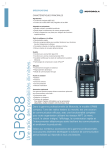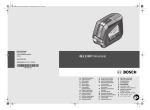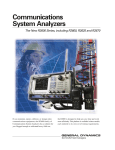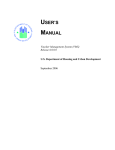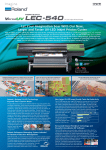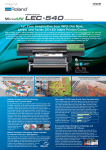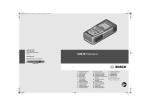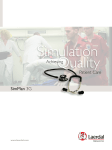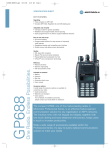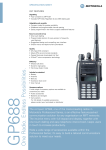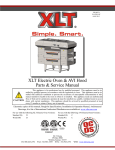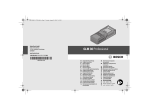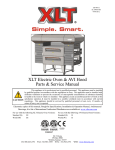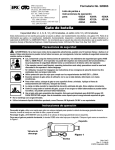Download The Motorola R-2680: A Basic Description.
Transcript
The Motorola R-2680: A Basic Description. The R-2680 Communications System Analyser is a radio test instrument that tests and performs service on the following equipment: • Two-way radios • MPT 1327/1343 radios • Pagers In addition, the R-2680 is used for manufacturing tests and engineering design. The R-2680: It’s the best test for two-way conventional and MPT trunked radios and pagers. Motorola Communications Test Equipment is proud to present the R-2680 with optional MPT 1327/1343 trunking test capability. If you need to calibrate, maintain, service or design radio communications equipment – including two-way conventional and MPT trunked radios and pagers – the Motorola R-2680 is for you. Because of its unique design, the R-2680 allows you to perform many complex functions with one single piece of equipment. This “one box” design is particularly helpful in remote sites where multiple pieces of heavy equipment are either impractical or impossible. The R-2680 is rugged enough to withstand heavy activity. It also has the flexibility of being operated from a variety of power sources, making it ideal for use in the field. The R-2680 is designed to save you time and help you work more efficiently – all of which improve your profit. Whether used in your shop, at your customer’s site or in a remote location, let the Motorola R-2680 – and our experience – work for you. Features and benefits. The R-2680 gives you cost savings and space savings because it does the job of each of these individual test instruments: • Signal Generator • Measurement Receiver • RF Scanner • Spectrum Analyser • Duplex Generator • Audio Frequency Counter • AC / DC Voltmeter • Digital Oscilloscope • RF Wattmeter • Signal Strength Meter • SINAD Meter • Distortion Meter • Tracking Generator • Signaling Simulator The R-2600 family of Communications System Analysers is known for its user-friendly efficient operation. The R-2680 is no exception because: The display is organized into easy-toread windows for quick comprehension of test results Test settings and results are displayed simultaneously, eliminating the need to switch between screens Soft keys permit quick access to the many menu selections, simplifying test setups Built-in memory easily stores and recalls frequently used configurations Built-in “help screens” give instant access to user information The result is a reduction in the cost of servicing and testing equipment, simply because both functions can be accomplished quickly and efficiently with the R-2680. Feature Summary: RF Functions: Selectable from RF Control Zone • RF Monitor • Sweep Generator • RF Generator • Tracking Generator (Optional) • Duplex Generator Modulation and Audio: Modulation: Selectable from RF Control Zone • Frequency Modulation (FM) • Wide Band and Narrow Band Format • Amplitude Modulation (AM) • Phase Modulation (PM) Optional Audio: Selectable from Audio Control Zone Also refer to Meter Modes: Signal Decoding • Fixed 1 kHz Tone • A/B Sequence Tones • Private-Line • General Sequence Tones • Digital Private-Line • Tone Remote • Tone A • Dual Tone Multi Frequency • Tone B (DTMF) • 5/6 Paging Tones • External Modulation Input • Select 5 Tones Graphic Display Functions: Selectable from Display Control Zone This Zone can be expanded to fill the whole screen • Spectrum Analyser • Bar Graphs • Modulation Scope • Tracking Generator Display • Oscilloscope (Optional) • Sweep Generator Display Measurement Functions: Selectable from Display Control Zone: Meter section • RF Display Frequency Modulation Measurement Frequency Error RF Level • RF Scan (usable as a frequency counter) • Preset Scan • AC / DC Voltmeter • Internal/External Distortion • SINAD Distortion and SINAD can also be measured using optional: C Message Filter CCITT Filter Selectable 600 Ohm or 1 Meg Ohm load • Signal Decoding Private-Line Digital Private-Line Dual Tone Multi Frequency (DTMF) General Sequence 5/6 Paging Tones Select 5 Tones • Audio Frequency Counter • Cable Fault (Optional) Options: MPT 1327 Analogue Trunking Option Radio and System Call Tests for the following formats: • Individual • Group • All • PABX (Private Automated Branch Exchange) • PSTN (Public Switch Telephone Network) • Status Message • Short Data Message Auto Test measurements (Maximum of 3 Channels): • SINAD • FM Deviation • Frequency error • RF Power Other features: • 10 predefined system parameters • 10 user system parameters definable • Recall Telegram screen for up to 99 Telegrams STANDARD FEATURES Standard features and benefits that make the R-2680 so powerful include: • RF signal generator with AM, FM and optional Phase Modulation • Sensitive measurement receiver • Duplex generator that provides increased service capability • Sweep generator combined with spectrum analyser for added applicability • Help screens provide instant assistance • Logical and complete parameter display • Convenient Soft key design • Single keystroke printing of screen graphics and parameters • Self calibration for reliability and accuracy GRAPHIC DISPLAYS The R-2680 is equipped with these graphic displays: • Spectrum Analyser • Modulation Oscilloscope • External Oscilloscope • Bar Graph • Tracking Generator • Sweep Generator These displays can be viewed by imbedding them as one of the four windows/zones or by expanding them to full screen for more detailed viewing. With the High Performance Option, efficiency is enhanced with: • Markers for easy measurement of amplitude, frequency and duration • Increased frequency dispersion on the: – Spectrum Analyser – Tracking Generator (optional) The combined Tracking Generator and High Performance Options: • Eliminate the need for additional expensive instruments. • Facilitate on-site adjustments of cavity filters and duplexers. PROGRAMMABLE TEST CONFIGURATIONS The R-2680 greatly improves the efficiency of engineers and technicians because it allows the most commonly-used test parameters to be easily stored and recalled when needed. The R-2680 can store and recall: • Up to 30-channels • Up to 15 additional test set-ups with: – All test conditions – Measurement display formats – Signal or spectrum characteristics TONE-SIGNALING ENCODING AND DECODING The R-2680 provides the capability to encode and decode: • Select 5 • Private-Line (PL) • Digital Private-Line (DPL) • Single tone • Two tone sequences • Multi-tone sequences • DTMF signals • 5/6 tone paging • 20 tones in a sequence MPT 1327/1343 ANALOGUE TRUNKING OPTION The MPT 1327/1343 option offers: • User-friendly interface for MPT1327/1343 testing – All major MPT 1327/1343 standard configurations are pre-defined and Soft key-selectable – Additional parameters or new system configurations can be easily entered and stored – Autotest quickly pinpoints most radio faults • Tests all standard call/receive sequences • Provides history storage for 99 call/receive telegrams • Displays all parametric test results on one screen Specifications Receiver Test Mode: RF Generator: Frequency Range: 400 kHz to 1 GHz Resolution: 100 Hz Accuracy: Refer to the accuracy of the time base Stabilization Time: 0.1 Second Output Level: Range in Frequency Modulation: RF I/O port: -130 dBm to -50 dBm Gen out port: -80 dBm to 0 dBm Range in Amplitude Modulation: RF I/O port: -130 dBm to -50 dBm Gen out port: -80 dBm to -3 dBm Accuracy: ±2 dB from -80 to -130 dBm (RF I/O Port) ±4 dB for all other output levels and ports over the 3 MHz to 1 GHz range. Spectral Purity: Spurious: -35 dBc within ±20 MHz of selected carrier frequency. Additional fixed spurs at an absolute level of <90 dBm at harmonic frequencies of 5 MHz. (These can affect level and modulation measurements when operated at low levels at or very near these specific frequencies.) Harmonics: -20 dBc Frequency Modulation: Deviation: 99.5 kHz Accuracy: 5% of setting ±25Hz @ 1 kHz (NB) 5% of setting ±250Hz @ 1 kHz (WB) Residual FM: 20 Hz max @ 300 Hz to 3 kHz from center frequency Internal / External Frequency Range: 5 Hz to 20 kHz, ±2 dB Amplitude Modulation: Range: 0 to 90% Accuracy: 10% of Modulation Residual AM: 1.0% max @ 300 to 3 kHz from center frequency Internal / External Frequency Range: 100 Hz to 10 kHz, ±1 dB Phase Modulation: (Optional Feature) Range: 0.5 to 10 radians Accuracy: ±8% at 1 kHz Resolution: 0.1 radians (0.01 below 2.00 radians) Internal / External Frequency Range: 300 to 3000 Hz Receiver Test Mode continued Sweep Generator: Range: 400 kHz to 1 GHz Resolution: 100 Hz Output Level: -130 dBm to 0 dBm Sweep Width: Selectable up to ±5 MHz of center frequency Scope Coupling: Synchronized scope trace to the sweep signal Accuracy: Refer to the accuracy of the time base Duplex Generator: Range: 400 kHz to 1 GHz Resolution: 100 Hz Output Level: -130 dBm to 0 dBm Frequency Offset: 0 to ±55MHz in 5 kHz steps Accuracy: Refer to the accuracy of the time base Transmitter Test Mode: RF Monitor: Frequency: Range: 400 kHz to 1 GHz Resolution: 100 Hz Accuracy: Refer to the accuracy of the time base Spurious Response: 40 dB typical Sensitivity: (Above 10 MHz) Narrow band FM: 2.0 uV for 10 dB EIASINAD Wide band FM: 10 uV for 10 dB EIASINAD Scan Modes: Preset Scan: In monitor mode scans up to 30 user-defined preset frequencies which are stored in the preset memory and locks on signals within the following level range: • >-30 dBm at the Antenna Port • >+20 dBm at the RF I/O Port refer to the programable test memory specification Frequency Scan: In Monitor Mode scans user-defined frequency range from 20MHz to 1GHz, and locks on signals within the following level range: • >-30 dBm at the Antenna Port • >+20 dBm at the RF I/O Port Accuracy: Refer to the accuracy of the time base FM Deviation Measurement: Demodulation Range: ±5kHz Maximum in Narrow band ±75kHz Maximum in Wide band Accuracy: ±5% plus peak Residual FM Frequency Response: Selectable per the following: Low Pass Filters 20 kHz, 3 kHz, 300 Hz High Pass Filters 5 Hz, 300 Hz, 3 kHz Demodulated Output Level: • 0.8V Peak per 1 kHz peak Deviation in Narrow band • 0.8V Peak per 10 kHz peak Deviation in Wide band Demodulation Output Impedance: 100 Ohms nominal Deviation Alarm: Audible alarm, Selectable in 100 Hz increments AM Modulation Measurements: Demodulation Range: 0 to 100% Accuracy: ±5% for levels below 80% Frequency Response: Selectable per the following Low Pass Filters 20 kHz, 3 kHz, 300 Hz High Pass Filters 5 Hz, 300 Hz, 3 kHz Demodulated Output Level: 0.8 V peak per 10% AM Modulation Demodulation Output Impedance: 100 Ohms nominal Phase Modulation Measurements: (Optional) Demodulation Range: Narrow band = 1 radian Wide band = 10 radians Accuracy / Frequency Response: ±5%, ±0.1 rad, ± residual noise at 1 kHz ±7.5%, ±0.1 rad, ± residual noise; 300 to 3500 Hz Demodulation Output Impedance: 100 Ohms nominal Transmitter Test Mode continued Wattmeter (RF I/O Port): MPT 1327: (Optional Feature) Frequency Range: 3 MHz to 1 GHz Measurement Range: 0.1 Watt to 125 Watts Input Impedance: 50 Ohms with a maximum VSWR of 1.5 : 1 Accuracy: ±10% Protection: Audible Over Temperature Alarms Signaling Types: Germany Regionet 43 Sub-bands D1 & D2, UK MPT1327 Band III Sub-bands I & II, Dutch Actionet, Italian Privatex, New Zealand PTC 253, French PAA2424 VHF, French PAA2424 UHF, and Finnish Autonet predefined. User configurable Signaling Types: Non-volatile storage of up to 10 user defined signaling types. Call sequence Tests: Radio & System Initiated: • Individual Call • Group Call • All Call • PABX Call • PSTN Call • Status Message • Short Data Message MPT 1327 Test Parameter Entries: (Dependent on Test Selection) • Signaling Type • System ID • Control Channel Number • Traffic Channel Number • Call Sequence • Emergency Priority • Call Set-up • Radio ID2 (for System Initiated Tests) • Group ID • Group Call Type • Status Code • Data Codewords • Signaling Parameters Test Measurement Display: (Dependent on Test Selection) • Radio ID • Radio ESN • Call Status Indicator • Control Channel Frequency • Traffic Channel Frequency • Emergency Priority • Group ID • Group Call Type • PABX Number • PSTN Number • Status Code • Data Codewords • Raw Telegrams (Storage for last 99) • RF Performance Data Auto Test Capability: Test up to 3 Traffic Channels for quick SINAD, Frequency Error, Frequency Deviation, and RF Power Measurements. Radio ID Decoding: MPT 1327 Format: Prefix-Ident Frequency Error Meter: Type of Display: Autoranging Resolution: 1Hz Signal Strength Indicator: Range: 3 MHz to 1 GHz Accuracy: ±4 dB Sensitivity: -100 dBm (Antenna Port Rating) Spectrum Analyser: Frequency Range: 400 kHz to 1 GHz Dispersion: Selectable from keypad 200 kHz window (20 kHz / Div) 500 kHz window (50 kHz / Div) 1 MHz window (100 kHz / Div) 2 MHz window (200 kHz / Div) 5 MHz window (500 kHz / Div) 10 MHz window (1 MHz / Div) Optional: 20 MHz window (2 MHz / Div) 50 MHz window (5 MHz / Div) 100 MHz window (10 MHz / Div) Dynamic Range: 60 dB Bandwidth: 6 kHz / 30 kHz automatically selected Display Range: +50 to -95 dBm Optional Markers: Freeze Max Hold Peak Hold Delta (Level, Frequency) Absolute (Level, Frequency) Test Diagnostics: Oscilloscope: Preset Memory: Up to 30 channel preset stores the following userprogrammed test parameters: Monitor Frequency Modulation Types Generator Frequency Modulation Type Bandwidth Duplex Offset Synthesizer Format Select DTMF Test Setups: Up to 15 test setups store user-programmed test setups which are independant of the presets. These include: All test conditions All measurement display formats All signal levels Frequency Response: 0 to 50 kHz Vertical Input Ranges Selectable 10 mV, 20 mV, 50 mV, 100 mV, 200 mV, 500 mV, 1 V, 2 V, 5 V, 10 V Per Division Accuracy: 5% of full scale all ranges Sweep Ranges: Selectable 20 µsec, 50 µsec, 100 µsec, 200 µsec, 500 µsec, 1 msec, 2 msec, 5 msec, 10 msec, 20 msec, 50 msec, 100 msec, 200 msec, 500 msec, 1 sec Per Division Trigger: Automatic Normal Single Sweep Optional Markers: Delta Voltage Delta Frequency Delta Period Tracking Generator: (Depends on model) Digital Voltmeter: Frequency Range: 400 kHz to 1 GHz Tracking Display Sweep Range: 200 kHz window (20 kHz / Div) 500 kHz window (50 kHz / Div) 1 MHz window (100 kHz / Div) 2 MHz window (200 kHz / Div) 5 MHz window (500 kHz / Div) 10 MHz window (1 MHz / Div) 20 MHz window (2 MHz / Div) 50 MHz window (5 MHz / Div) Display Range: 0 to -80 dBm Meter Type: RMS Frequency Range: DC AC of 50 Hz to 20 kHz DC Voltage Ranges: 1.0V full scale 10.0V full scale 100.0V full scale Accuracy: 1% full scale, ±1 least significant digit AC Voltage Ranges: 1.0V full scale 10.0V full scale 70.0V full scale Accuracy: 5% full scale, ±1 least significant digit Frequency Response: 3 dB end points @ 50 Hz and 20 kHz Programmable Test Memory: Cable Fault: (Optional) Method: Standing Wave Analysis Measurement: Cable Fault Distance from Analyser port, Cable Length Reading: Meters and Feet Accuracy: 10% Frequency Counter: Frequency Range: 5 Hz to 500 kHz Plus Auto-Tune Period Counter Range: 5 Hz to 20 kHz Input Level: 0.1V RMS. minimum Period Counter Resolution: Varies with frequency range. 5 Hz to 500 Hz = 0.1 Hz 500 Hz to 2 kHz = 1 Hz 2 kHz to 5 kHz = 10 Hz 5 kHz to 20 kHz = 100 Hz SINAD / Distortion Meter: Input Level: .1 V to 10 V RMS SINAD Accuracy: ±1 dB at 12 dB SINAD Distortion Range: 1% to 20% Distortion Accuracy: ±0.5% of distortion or ±10% of reading, whichever is greater Test Diagnostics continued System Operating: Audio Signal Types: • Fixed 1 kHz Tone • Private-Line (PL) • Digital Private-Line (DPL) • Tone A • Tone B • 5/6 Paging Tones • Select 5 Tones • A/B Sequence Tones • General Sequence Tones • Tone Remote • Dual Tone Multi Frequency (DTMF) • External Modulation Inputs Microphone BNC input Frequency Range: 10 Hz to 20 kHz ±1 dB Mod Output Level: Selectable to 7.95V Peak Mod Output Impedance: 100 Ohms Nominal 1kHz Tone Distortion: Not to exceed 1% External Modulation Inputs: Front Panel Jack for HMN-1056D Microphone Front Panel BNC Jack BNC Input Impedance: 600 Ohms Nominal Microphone Input Conditioning: Internal Audio Limiting providing IDC and Pre-emphasis. Power and Environmental: AC Power: 100 - 130 VRMS or 200 - 260 VRMS @ 50 Hz to 440 Hz DC Power: +11 to +16 VDC Battery Pack Option: +13.6 VDC, 50 Minutes Typical Weight: Basic Model: 15kg or 33 Pounds Temperature: 0 to +50° C (Operating) -40 to +85° C (Storage) Dimensions: Excluding accessories, battery pack and cover: 21.6 cm high x 40.7 cm wide x 43.2 cm deep or 8.5” high x 16” wide x 17” deep Time Base: Standard: Temperature Compensated Crystal Oscillator (TCXO): Aging 1 PPM per year, Temperature 1 PPM Optional: Oven Controlled Crystal Oscillator (OCXO): Aging .5 PPM per year, Temperature .05 PPM Interface Ports: Tone Sequence Decode: Modulation Types: Private-Line (PL) Digital Private-Line (DPL) Dual Tone Multi Frequency (DTMF) 5/6 Paging Tones Select 5 Tones General Sequence Tones Frequency Accuracy: ±3% from 300 Hz to 3 kHz Duration Accuracy: ±12 msec for tones greater than 30 msec and 300 Hz Printer and Remote Control: RS-232 DB25 (Female) IEEE488.2 (Optional) Color Monitor: Standard CGA, RGB DB9 (Female) MODEL NOMENCLATURE R-2680A R-2680AHS R-2680ANT R-2680ANTHS Communications System Analyser with Tracking Generator and programmable Test Setups as standard features. Communications System Analyser with Tracking Generator,programmable Test Setups and high stability Master Oscillator (OCXO). Communications System Analyser with programmable Test Setups as standard feature. Communications System Analyser with programmable Test Setups and high stability Master Oscillator (OCXO). R-2680 Power Cord Ordering Information The power cord supplied with the R-2680 must be specified on the purchase order as a no-charge option. Failure to specify a power cord will delay order acceptance. The nocharge power cord option part numbers begin with the letter “C.” For example: C006 specifies India standard power cord for R-2680 To purchase a spare or replacement power cord, the purchase order must specify the power cord as an accessory. Accessory power cord part numbers begin with the letter “P.” For example: P004 specifies Japan standard accessory power cord. No-Charge Accessory Plug Reference Country Option Part # Part # Pattern or Region OPTIONS C001 P001 North America/USA Canada/Mexico Central America C002 P002 Continental Europe (Style CEE7/7) C003 P003 United Kingdom C004 P004 Japan (Note: Not compatible with North American standard) C005 P005 Australia/ New Zealand C006 P006 India/Pakistan/ Bangladesh/ South Africa/ (old British style) C007 P007 Israel C008 P008 Italy C009 P009 Switzerland (Note: Not compatible with IEC906-1 standard) C010 P010 Switzerland FACTORY INSTALLED OPTIONS RLN-1022A RLN-1023A RLN-4034A RLN-4361A RLN-4329A RLN-4306A RLN-4423A Signaling hardware module Software Option MPT1327 (necessary for MPT 1327; requires RLN-1022A) C-Message Filter 600 Ohm Meter Load CCITT Filter 600 Ohm Meter Load IEEE 488.2 Interface Cable Fault Locator 100 MHz Spectrum Analyser with Markers ACCESSORIES SUPPLIED WITH R-2680 (May also be purchased as additional spare accessories.) HMN-1056D TEKA-24A 58-80386B73 RTL-4011A 58-84300A98 RPX-4097A GG-6530277C002 68-80309F50 Microphone Power Cord (see chart) Whip Antenna 50 Ohm Termination Load Oscilloscope Probe Adapter N to BNC DC Power Connector Kit Spare RF Fuses Operator Manual OPTIONAL RPN-4000A 1580357B77 A-001 RTA-4000A 5880345B96 RLN-4375A 3080387B58 3080387B59 3080387B60 HLN-9390A 6880309E55 RLN-4120C RLN-4075A Battery Pack Canvas Case Transit Case Telescoping Antenna RF Probe (50 Ohm) Serial/Parallel Dot Matrix Printer Serial Printer Cable RS232 Cable (DB25M - DB9F) CGAMonitor Cable RS232 Adapter (DB9M - DB25F) Programming Reference Manual (RS232 and IEEE 488.2) Service Manual RF Detector Probe










